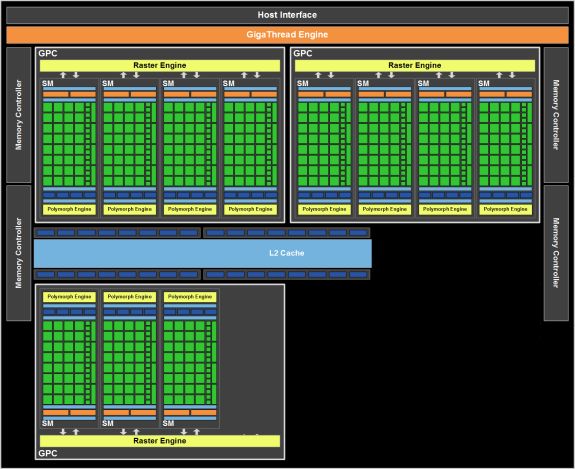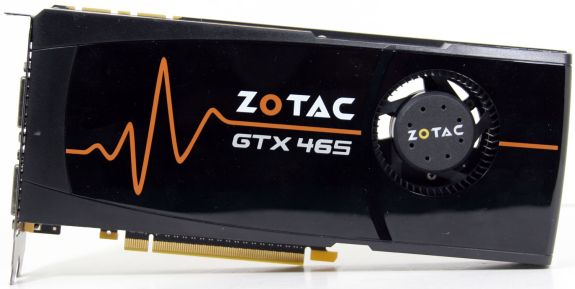
Original Link: https://www.anandtech.com/show/3745/nvidias-geforce-gtx-465
NVIDIA's GeForce GTX 465: Cheaper Isn’t Always Better
by Ryan Smith on May 31, 2010 3:26 AM ESTIn recent years it’s become customary to have 3-4 high-end cards on the market at the same time using the same GPU. For the GTX 200 series we had the GTX 260, GTX 275, and GTX 285, while for the Radeon HD 5000 series we have the 5830, 5850, and 5870. With the launch of NVIDIA’s GTX 400 series last month NVIDIA filled in the first 2 spots in their lineup with the GTX 480 and GTX 470, with obvious room to grow out the family in the future.
Above the GTX 480 is of course the “full” GF100 with all of its functional units enabled, and which is still missing in action on both the consumer and HPC markets. However there’s also room for a card below the $350 GTX 470, particularly with AMD being the sole inhabitant of the “bargain” high-end $300 point. NVIDIA is to the point in the Fermi rollout where they want a piece of that market, and they have a stash of further-binned so-so GF100 chips they want to fill it with. This brings us to today, and the launch of the GeForce GTX 465.
| GTX 480 | GTX 470 | GTX 465 | GTX 285 | |
| Stream Processors | 480 | 448 | 352 | 240 |
| Texture Address / Filtering | 60/60 | 56/56 | 44/44 | 80 / 80 |
| ROPs | 48 | 40 | 32 | 32 |
| Core Clock | 700MHz | 607MHz | 607MHz | 648MHz |
| Shader Clock | 1401MHz | 1215MHz | 1215MHz | 1476MHz |
| Memory Clock | 924MHz (3696MHz data rate) GDDR5 | 837MHz (3348MHz data rate) GDDR5 | 802MHz (3208MHz data rate) GDDR5 | 1242MHz (2484MHz data rate) GDDR3 |
| Memory Bus Width | 384-bit | 320-bit | 256-bit | 512-bit |
| Frame Buffer | 1.5GB | 1.25GB | 1GB | 1GB |
| Transistor Count | 3B | 3B | 3B | 1.4B |
| Manufacturing Process | TSMC 40nm | TSMC 40nm | TSMC 40nm | TSMC 55nm |
| Price Point | $499 | $349 | $279 | N/A |
In a nutshell, if you take a GTX 470 and disable some additional functional units, additional memory controllers, and additional ROPs, while turning down the memory speed any further, you get the GTX 465. NVIDIA has shut off another 3 Streaming Multiprocessors (SMs) from GF100, leaving the GTX 465 with 11 of them, giving it a total of 352 CUDA Cores/SPs, and 44 texture units. Meanwhile the ROPs have been cut down to 32 ROPs, and another memory controller disabled, making for a 256-bit memory bus attached to 1GB of 802MHz (3208MHz effective) GDDR5. All told the GTX 465 has around 78% of the texture/shader power of the GTX 470, 80% the ROP power, 76% of the memory bandwidth of the GTX 470, and 80% of the memory capacity. The loss of 256MB of RAM will be particularly interesting, as it means NVIDIA has surrendered its memory capacity advantage over AMD’s reference cards – both are even at 1GB.
With all of that in mind, compared to the GTX 470 the GTX 465 may be the more interesting card. While NVIDIA simply disabled some additional functional units compared to the GTX 480 to get the GTX 470, disabling even more functional units required a different strategy. Rather than disabling additional units from each of the GF100 GPU’s 4 Graphics Processing Clusters (GPCs), NVIDIA outright disabled one of the GPCs. This is the first time we’ve seen them disable a GPC on a GF100 card, making it an interesting first for Fermi. By disabling a GPC, not only does NVIDIA surrender CUDA cores, texture units, and polymorph engines, but they also surrender one of the 4 raster engines. As a result the GTX 465 takes a straight 25% hit in rasterization abilities compared to GTX 470, slightly greater than the loss for any other part of the GTX 465.

Top: GTX 465. Bottom: GTX 470
Along with similar clockspeeds as the GTX 470, the GTX 465 also shares the GTX 470’s design. It’s the same PCB and cooler – only the GPU has changed, with NVIDIA’s partners laying down one of NVIDIA’s GTX 465-binned GF100 GPUs.
With the disabling of additional functional units, the TDP has come down compared to the GTX 470. NVIDIA pegs the GTX 465 at 200W TDP, 15W below the GTX 470’s official TDP. We were not given the idle power consumption; however we’ll see quickly that it hasn’t improved when looking at our own power consumption numbers.
As we stated earlier, this is NVIDIA’s shot at the sub-$300 market, which is currently dominated by the Radeon HD 5850 at $289 and up, and the Radeon HD 5830 at $225 and up. Like the GTX 470, NVIDIA has built a product to slot in between AMD’s cards in terms of performance rather than taking AMD head-on, and the pricing reflects this. The MSRP of the GTX 465 is $279 accordingly, maintaining AMD and NVIDIA’s more-or-less neat division of the high-end market and putting the performance “sweet spot” for the GTX 465's performance at roughly 93% of the 5850.
Meanwhile this is the closest the two have come on pricing in quite some time, as a $279 MSRP puts the GTX 465 within $10 of the cheapest Radeon HD 5850. The pricing on the GTX 465 may change in the next month as NVIDIA’s North American partners are currently packing in Just Cause 2 with the card (a last-minute deal as we understand it), so there may be some flexibility on pricing once that promotion ends and NVIDIA’s partners no longer have to chip in for the game.
Finally, this is a hard launch, a very hard launch. In fact the cards started showing up on etailers 2 days before our NDA expired. After the farce that was the GTX 480/470 launch, it’s fantastic to see a proper hard launch. As far as we can tell you won’t have any problem finding a GTX 465 – thanks in large part to what looks to be quite the stockpile of GF100 GPUs that only meet GTX 465 specifications.
Meet Zotac’s GeForce GTX 465
Unlike the GTX 480/470 launch, NVIDIA is not seeding the press with reference cards. Instead that task has been left up to the vendors, who are selling identical cards that we believe all come from NVIDIA. For our review Zotac was kind enough to send over their GTX 465, our first Zotac video card here at AnandTech.
As we said previously, the GTX 465 is built upon the same PCB/cooler as the GTX 470, so the cards are indistinguishable except for the Zotac branding and identification stickers on the card. Internally things are also the same, with Zotac’s GTX 465 using the same 5-pipe heatsink that we’ve seen on the GTX 470. NVIDIA’s own cooling recommendations also remain unchanged, with NVIDIA suggesting to space GTX 465 cards as far apart as possible when using them in SLI.
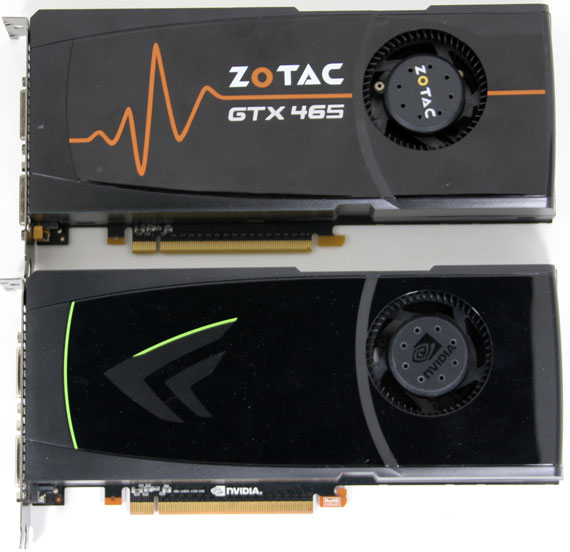
With the reuse of the GTX 470’s PCB, the layout of the card remains unchanged. For drawing power in is a pair of 6-pin PCIe power sockets, while driving the outputs are 2x DVI-I ports and a mini-HDMI port. Length also remains unchanged at 9.5”.
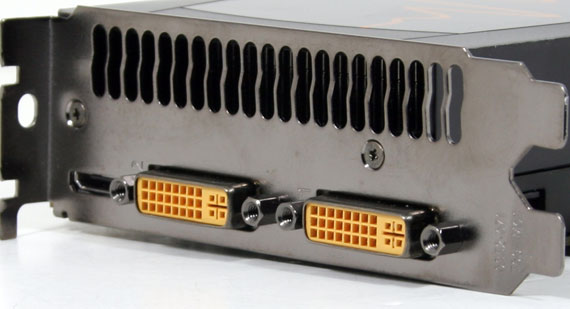
For pack-ins, Zotac is shipping the card with a pair of dual-Molex to PCIe 6-pin power adaptors, a DVI to VGA dongle, and a mini-HDMI to HDMI dongle. The included documentation is composed of the usual English-language generic user’s manual and an equally generic multilingual quick installation guide.
The software pack-in is composed of a CD containing NVIDIA’s 197.75 drivers, and trial versions of Badaboom, vReveal, Super LoiLoScope, and bitDefender. Our copy did not include Just Cause 2 since it arrived before NVIDIA’s last-minute inclusion of the game, however we have confirmed that the actual retail cards will include it. This will be a coupon to download it from a digital distribution service, rather than a pressed disc.
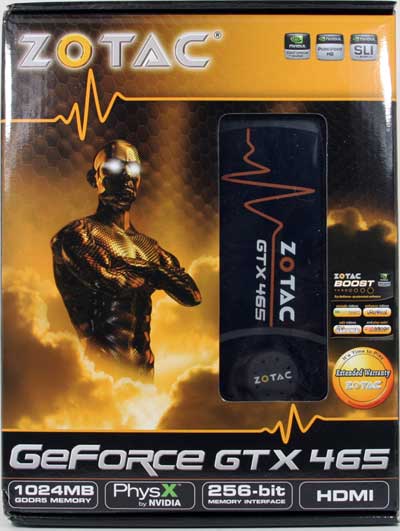
Finally, Zotac is offering a lifetime warranty on their GTX 465 (registration required). As you may recall in our GTX 480/470 review we were left uneasy by the cards’ high temperatures and recommended a lifetime warranty – the GTX 465’s operating temperatures are similar enough that we would make the same recommendation, so this is right up that alley.
For our testing we’re using NVIDIA’s new ForceWare 257.15 beta drivers, which were released last week. We’ll have a full workup on them a bit later this week, but for now it suffices to say that they have quite a performance kick to them, so we would not recommend using the 19X series drivers with the GTX 465 due to the lower performance of those drivers.
| CPU: | Intel Core i7-920 @ 3.33GHz |
| Motherboard: | Intel DX58SO (Intel X58) |
| Chipset Drivers: | Intel 9.1.1.1015 (Intel) |
| Hard Disk: | OCZ Summit (120GB) |
| Memory: | Patriot Viper DDR3-1333 3 x 2GB (7-7-7-20) |
| Video Cards: |
AMD Radeon HD 5970 AMD Radeon HD 5870 AMD Radeon HD 5850 AMD Radeon HD 5830 AMD Radeon HD 5770 AMD Radeon HD 5750 AMD Radeon HD 4890 AMD Radeon HD 4870 1GB AMD Radeon HD 4850 AMD Radeon HD 3870 NVIDIA GeForce GTX 480 NVIDIA GeForce GTX 470 Zotac GeForce GTX 465 NVIDIA GeForce GTX 295 NVIDIA GeForce GTX 285 NVIDIA GeForce GTX 275 NVIDIA GeForce GTX 260 Core 216 NVIDIA GeForce 8800 GT |
| Video Drivers: |
NVIDIA ForceWare 197.13 NVIDIA ForceWare 197.17 NVIDIA ForceWare 257.15 Beta AMD Catalyst 10.3a |
| OS: | Windows 7 Ultimate 64-bit |
Crysis: Warhead
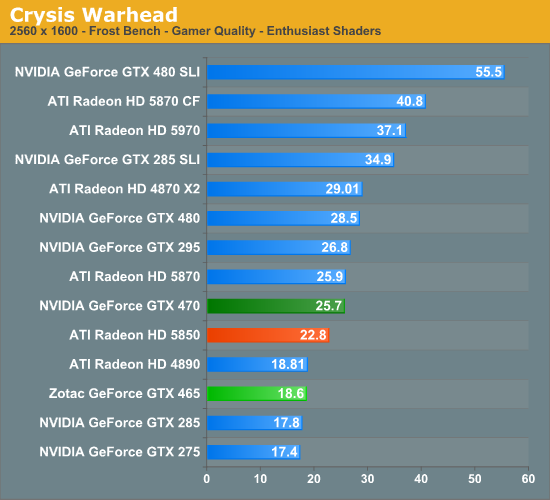
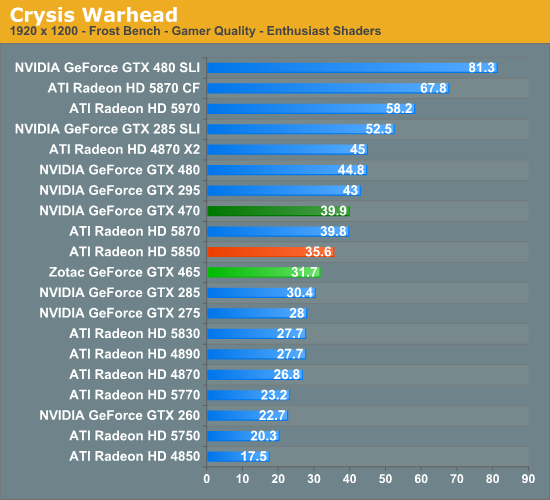
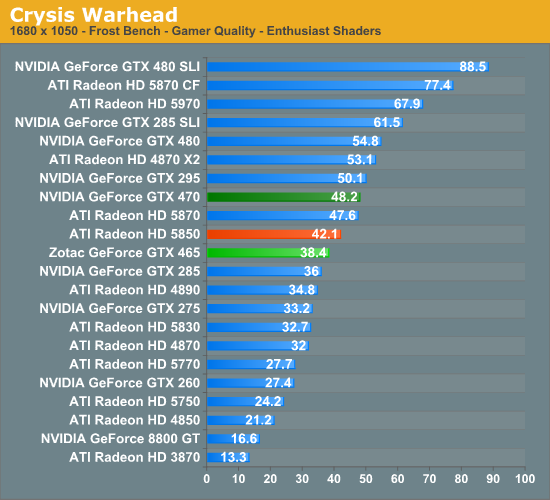
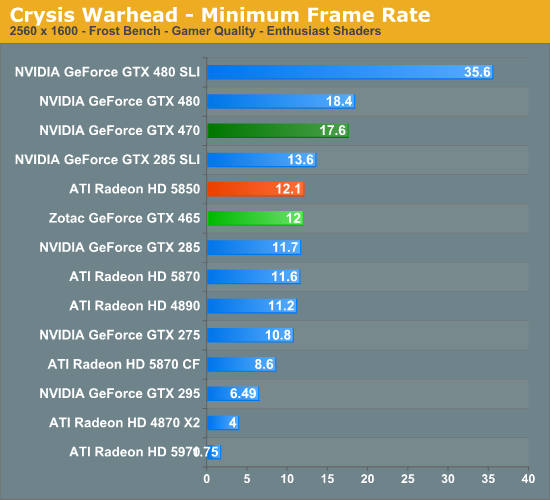
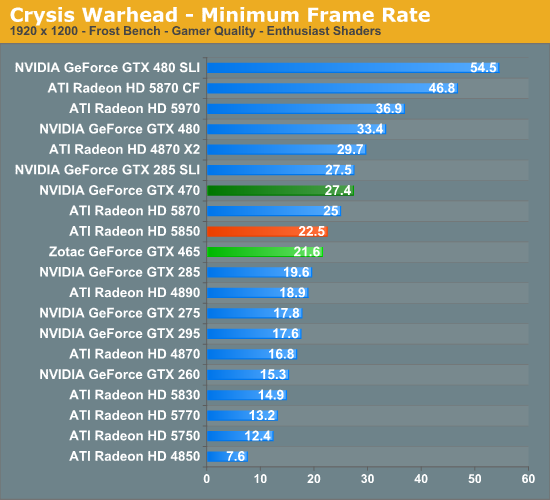
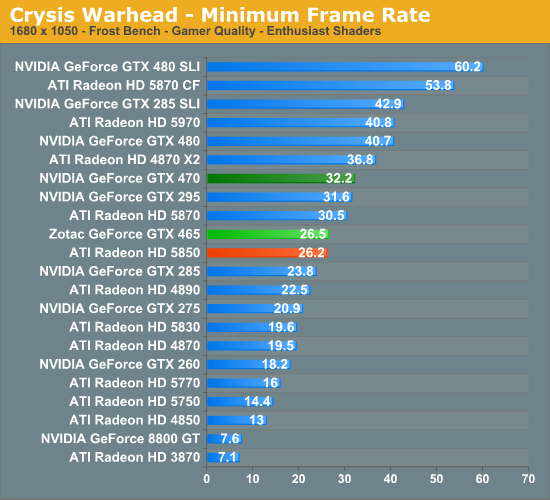
Kicking things off as always is Crysis: Warhead, the toughest game in our benchmark suite. The GeForce GTX 465 trails the Radeon HD 5850 by about 4fps at every resolution. This translates to within 91% and 82% of the 5850’s performance, with that gap increasing with resolution. Ultimately NVIDIA just misses the sweet-spot at lower resolutions. Meanwhile the minimum framerates are almost tied with the 5850, which is roughly what we expect based on the fact that the GTX 465 doesn’t have a memory capacity advantage like the GTX 480 and 470.
Meanwhile compared to the GTX 470, the GTX 465 is between 20% and 27% slower on average FPS, and 18%-32% slower for minimum framerates.
BattleForge: DX10
Up next is BattleForge, Electronic Arts’ free to play online RTS. As far as RTSes go this game can be quite demanding, and this is just at DX10.

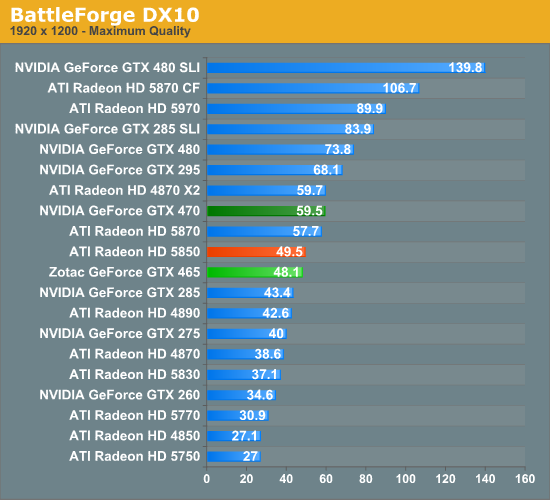
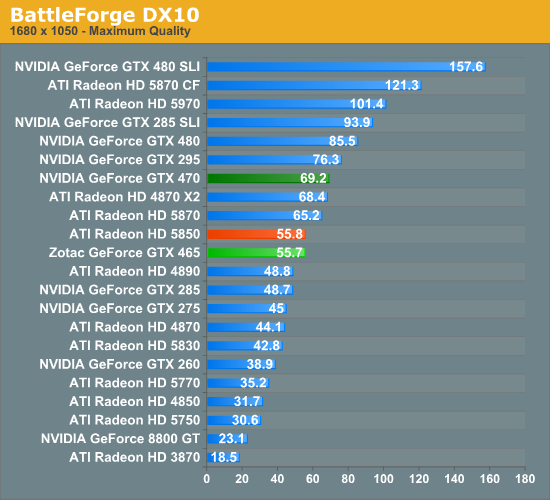
Until we get to 2560x1600, the 5850 and the GTX 465 are virtually in a dead-heat. The 5850 always maintains a slight advantage, but not enough to make a practical difference. At 2560 the GTX 465 finally cracks some, and falls behind by 8%. As for the GTX 465 in comparison to the GTX 470, it’s effectively always 20% behind.
BattleForge: DX11
While BattleForge can be tough under DX10, under DX11 it’s even more brutal. Here we use the DX11 renderer and turn on self shadowing ambient occlusion (SSAO) to its highest setting, which uses a DX11 ComputeShader.
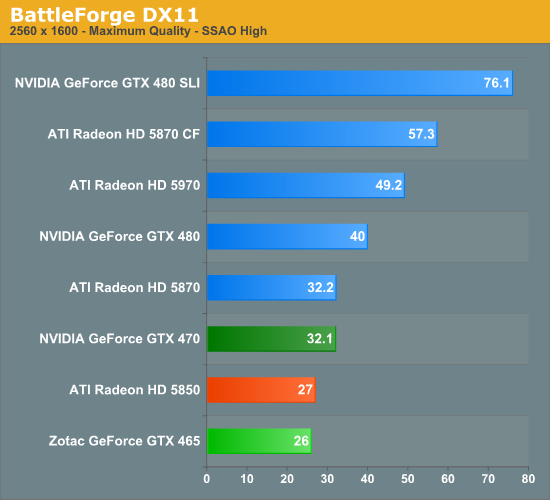
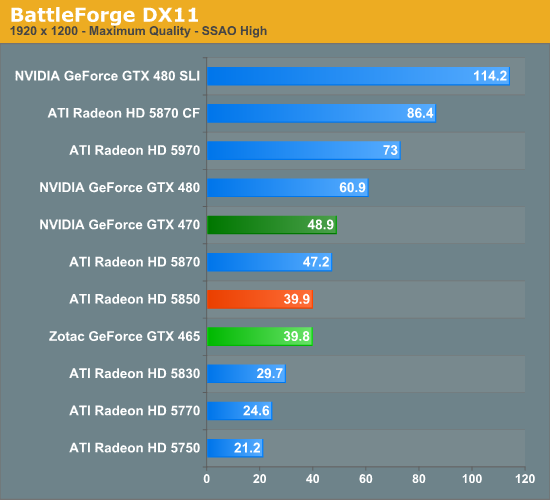
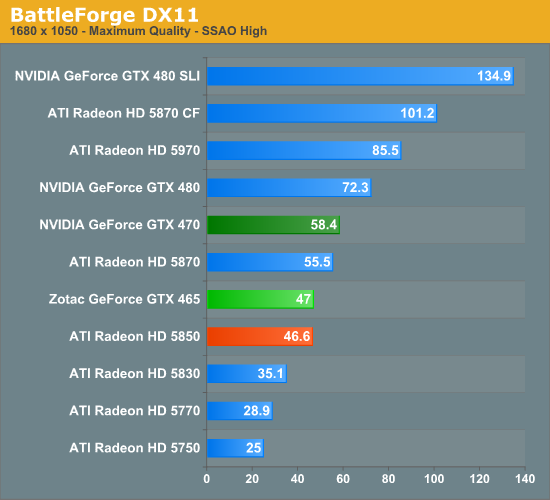
Once again we have a dead-heat between the GTX 465 and Radeon 5850, except this time it doesn’t break at 2560. At all resolutions the two cards are equally matched. Given that we’re not seeing a divergence at 2560 as we did earlier under DX10, this may point to the GTX 465 being better performing at ComputeShader 5.0 compared to the 5850. Our GTX 465/470 comparison also lends some credit to this idea, with the gap staying at 20%.
HAWX
Ubisoft’s aerial action game is one of the less demanding games in our benchmark suite, particularly for the latest generation of cards. However it’s fairly unique in that it’s one of the few flying games of any kind that comes with a proper benchmark.
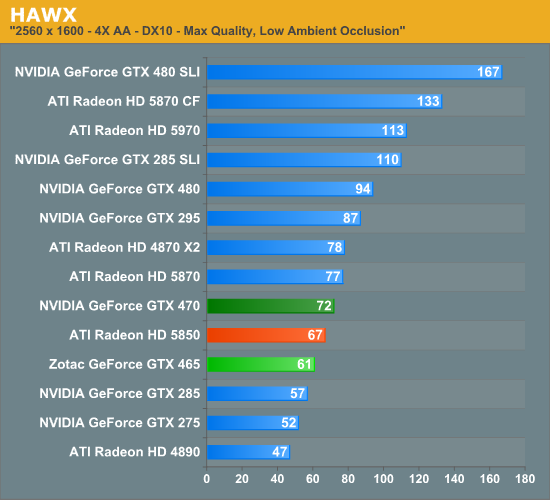
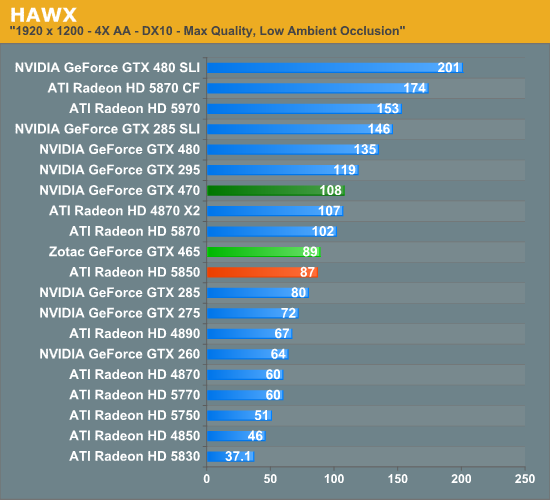
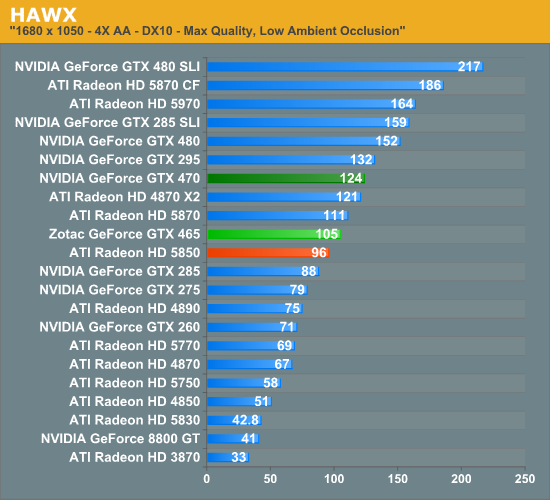
Given NVIDIA’s product positioning we weren’t expecting the GTX 465 to take too many leads over the 5850, so when it does it’s noteworthy. Here the GTX 465 starts with a 9% lead at 1680, 2% at 1920, and taking a loss of 9% at 2560. As we see the GTX 470’s lead melt away here when the resolution increases, this points to a likely bottleneck with the ROPs or memory bandwidth, as both would be heavily strained by our higher resolutions. Notably the GTX 470 and GTX 465 once again maintain a consistent relationship: the latter is slower by 16%-18%.
Left 4 Dead
Introduced in 2004, Valve’s Source engine continues to live on in new Valve games. At this point even newer Source games like Left 4 Dead are rarely GPU limited to a significant degree, but we keep it on here due to the fact that we’re expecting at least one more Source game this year in Portal 2.
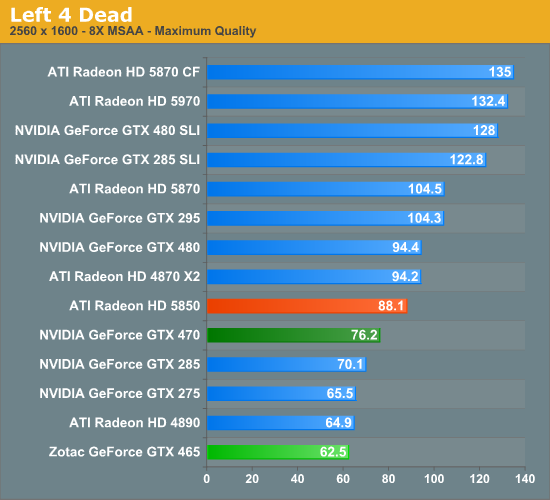
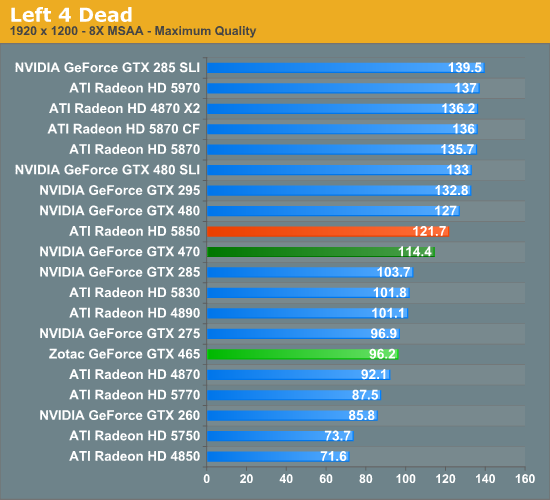
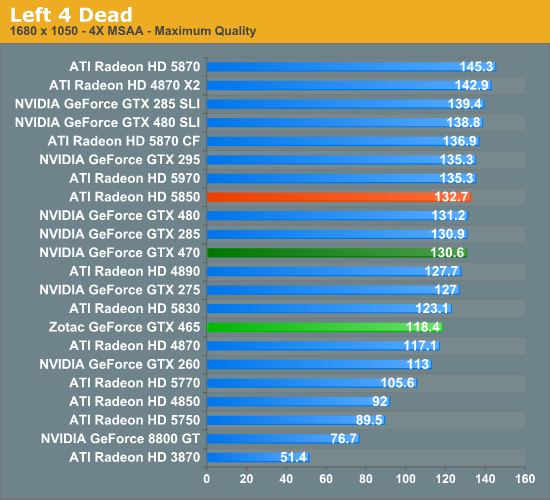
Left 4 Dead is not a game that favors the Fermi architecture, and this becomes all too clear with the GTX 465. At 1680 it falls behind by 10%, and at 2560 that increases to 30%. Notably this is our only game with 8x anti-aliasing, but as we saw in our GTX 480 review GF100 is no worse than AMD’s Cypress when it comes to 8x AA, so something else is the culprit. It could the lack of ROPs, but we’re also not willing to throw out the idea that it’s a texture filtering limitation.
Meanwhile we have something else interesting going on with the GTX 465: it’s not just losing to AMD’s cards. The GTX 465 ends up losing to the GTX 285 here, and even the GTX 275. Compared to the GTX 285 the GTX 465 is around 10% slower, which is quite surprising since we did not expect the GTX 285 to score any notable wins today. With L4D being fairly light on shader use, this leads us once more to the ROPs or texture units. Unless there’s an edge-case where the GTX 465 is slower than the linear difference between the two cards’ ROPs, the ROPs alone can’t explain this difference. The texture filtering difference between the two cards could explain this though.
Battlefield: Bad Company 2
The latest game in the Battlefield series - Bad Company 2 - is another one of our new DX11 games and has been a smash hit at retail. It’s also surprisingly hard on our GPUs, enough so that we can say we found something that’s more demanding than Crysis. As BC2 doesn’t have a built-in benchmark or recording mode, here we take a FRAPS run of the jeep chase in the first act, which as an on-rails portion of the game provides very consistent results and a spectacle of explosions, trees, and more.
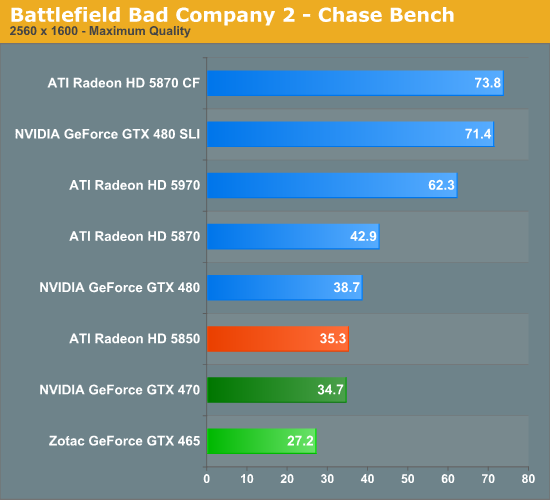
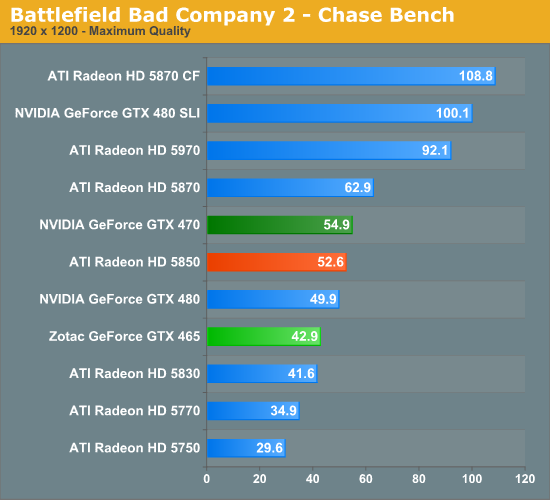
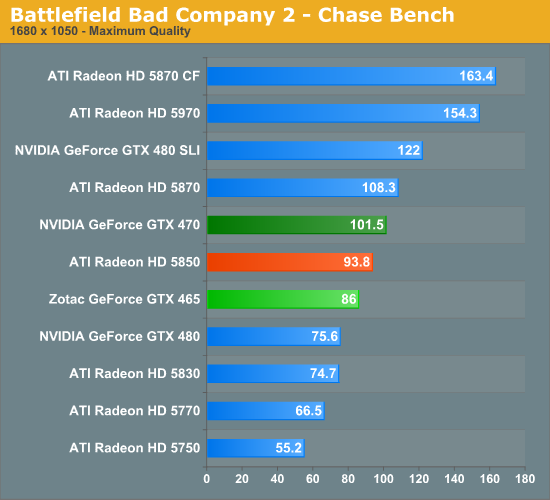
NVIDIA’s 257.15 drivers did a lot to improve Bad Company 2 performance, a very necessary thing given the GTX 400 series’ original poor showing at the game. As a result the gap is shorter than it once was, but the GTX 465 still takes it on the chin here. With an increase in resolution comes an increase in the gap between the GTX 465 and the 5850, starting at 9% and culminating at 23%. If NVIDIA can work a bit more out of their drivers the GTX 465 may close the gap at 1680, but it’s still going to be pretty far behind at any higher resolutions. NVIDIA does have an advantage here when it comes to image quality (specifically, anti-aliasing), which will jump in to with our comprehensive review of the 257.15 drivers later this week.
As for the GTX 470 versus the GTX 465, the GTX 465 stays within 78% and 84% of its bigger sibling.
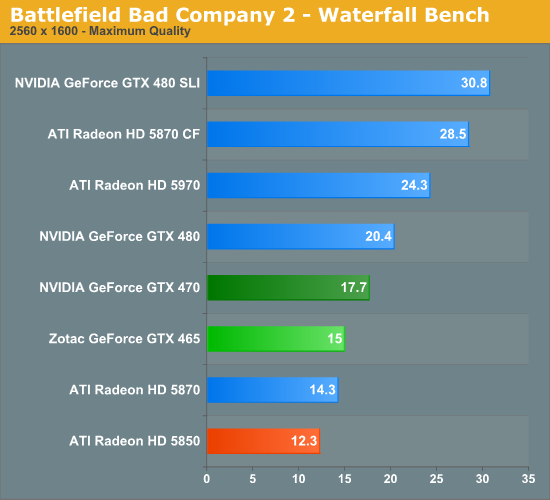
Meanwhile the Waterfall benchmark repeats something we saw on our initial GTX 480 review: NVIDIA does better than AMD when it comes to minimum framerates. We’ve been able to rule out a Video RAM advantage here thanks in part to the use of 1GB of VRAM on the GTX 465, so we have to look elsewhere to explain this. At this point we believe we may be shader bound, which would be to the GTX 465’s advantage.
STALKER: Call of Pripyat
The 3rd game in the STALKER series continues to build on GSC Game World’s X-Ray Engine by adding DX11 support, tessellation, and more. This also makes it another one of the highly demanding games in our benchmark suite.
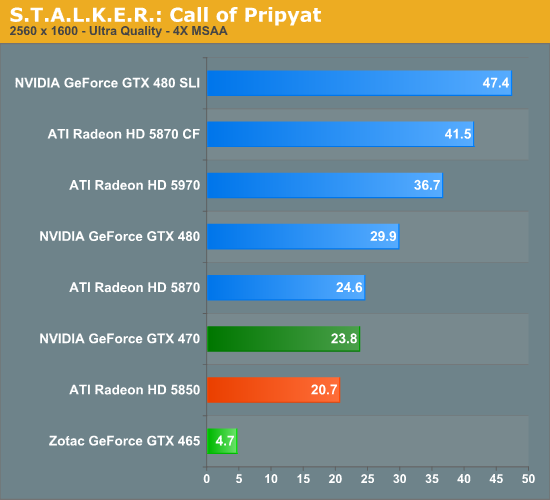
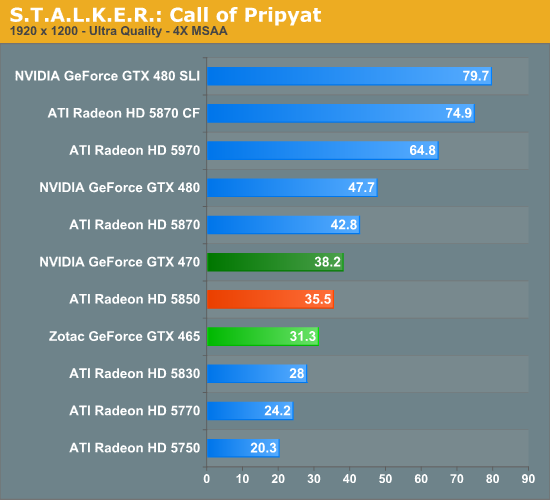
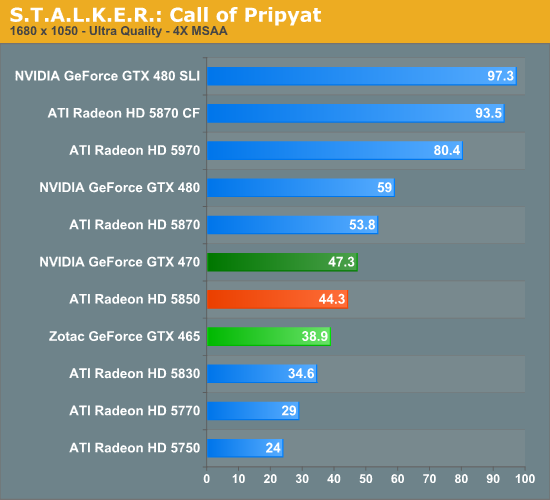
At lower resolutions, the GTX 465 does consistently worse than the 5850 – at both 1680 and 1920 it’s 12% behind. What’s more interesting is that at 2560 the GTX 465 gets absolutely demolished – that’s not a typo, it really did get 4.7fps. Why? We know that Stalker loves VRAM, which is why 2GB Radeon cards and NVIDIA’s other GTX 400 series cards do so well. But with only 1GB the GTX 465 pays the price. As for why the price is so severe, AMD and NVIDIA use different memory management strategies, so AMD is likely using a strategy that handles texture swapping under Stalker better than NVIDIA does. As a result the 5850 can generally cope, while the GTX 465 chokes. Ultimately this is not a game the GTX 465 will ever be playing at 2560.
DIRT 2
Codemasters latest racing game marks the return of a racer to our benchmark suite. As the first DX11 racer, DIRT 2 makes pretty through use of the DX11’s tessellation abilities, not to mention being the best looking racer we have ever seen.
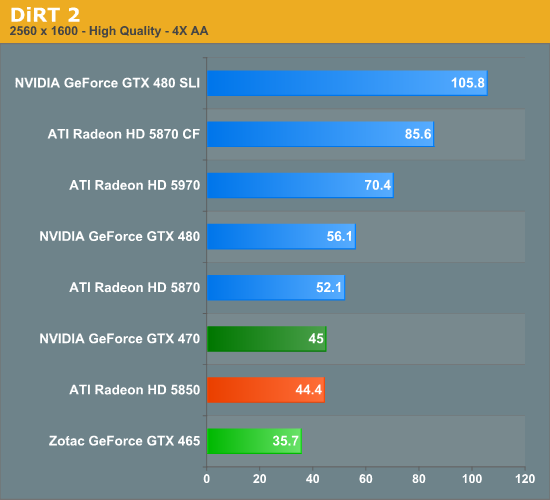
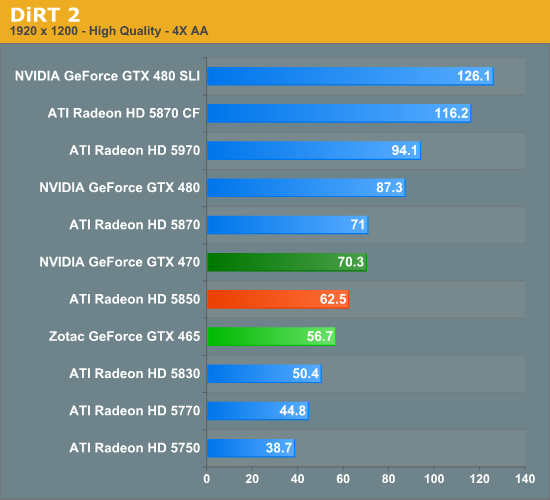
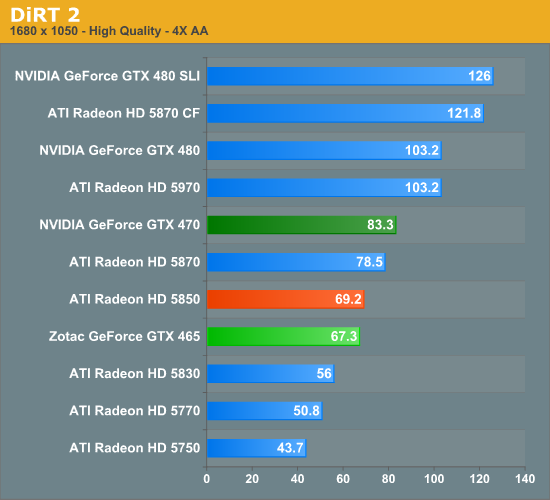
DIRT 2 was a game the earlier members of the GTX 400 series did fairly well at. However for some reason that goes out the window on the GTX 465, as a near-parity performance at 1680 becomes a 20% deficit at 2560. At 1920 (which we would consider the sweet-spot for this card) it falls behind by 10%. As far as we can tell, the Radeon 5000 series scales better with resolution on this game than the GTX 400 series does, and while this wasn’t too bad for NVIDIA since the GTX 470 started out well enough, starting out at near-parity for the GTX 465 only means things get worse.
Meanwhile getting back to our GTX 465/470 comparison, the gap remains constant – the GTX 465 falls behind by roughly 20%.
Mass Effect 2
Electronic Arts’ recently released space-faring RPG is our new Unreal Engine 3 game. While it doesn’t have a built in benchmark, it does let us force anti-aliasing through driver control panels, giving us a better idea of UE3’s performance at higher quality settings. Since we can’t use a recording/benchmark in ME2, we use FRAPS to record a short run.
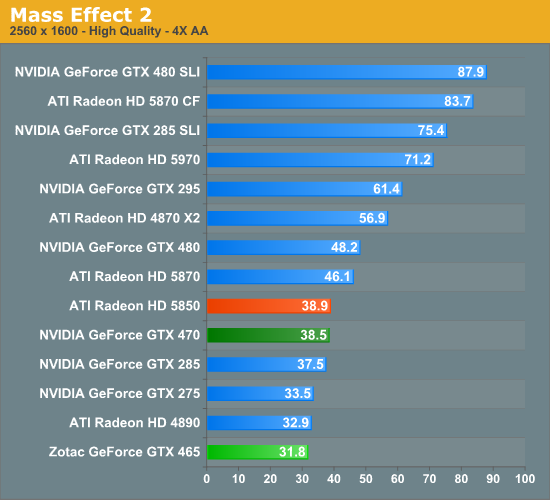
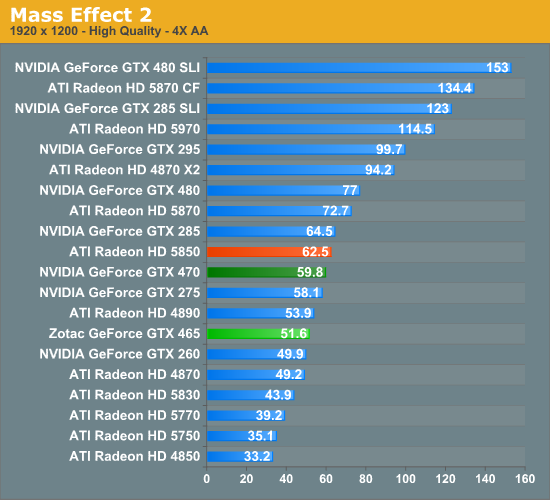
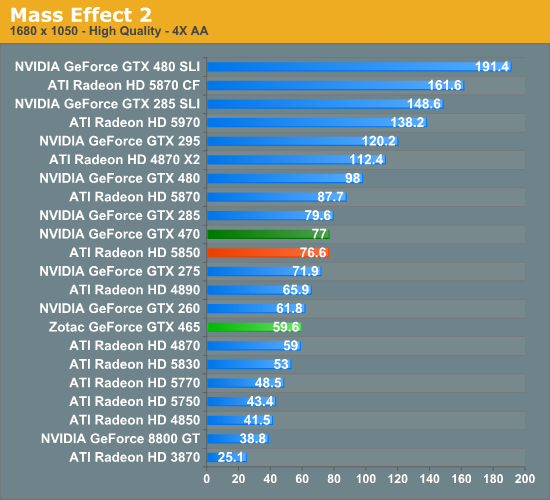
Mass Effect 2 was not a game the GTX 470 did particularly well at in the first place, so it should come as little surprise that the GTX 465 fares worse. The performance gap between it and the 5850 fluctuates some, but ultimately it’s around 20%. Interestingly enough, the gap between the GTX 465 and the GTX 470 fluctuates even more, with the deficit peaking at 1680 and shrinking to its lowest point at 1920.
Meanwhile we once again see the GTX 285 pull ahead of the GTX 465 in a game, and this time it’s even worse. The GTX 465 starts behind by 25% at 1680, and closes the gap to just 15% at 2560. Unlike Left 4 Dead, Mass Effect 2 is not a particularly easy game to render, so this isn’t just a case of the GTX 465 trailing with lighter games. Perhaps it’s optimization issues or perhaps it’s those texture filtering units, but the GTX 465 is definitely lacking something compared to the GTX 285.
Wolfenstein
Finally among our revised benchmark suite we have Wolfenstein, the most recent game to be released using the id Software Tech 4 engine. All things considered it’s not a very graphically intensive game, but at this point it’s the most recent OpenGL title available. It’s more than likely the entire OpenGL landscape will be thrown upside-down once id releases Rage later this year.
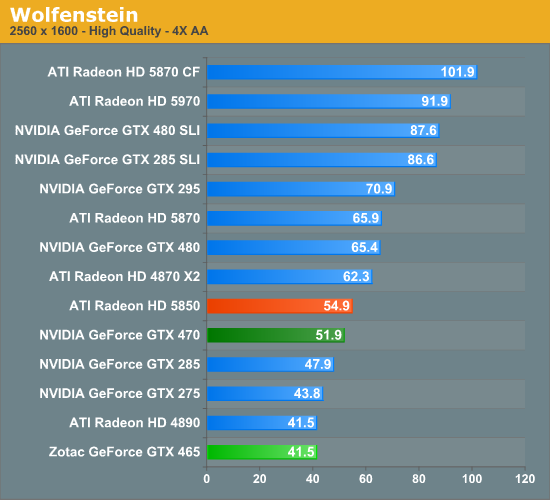
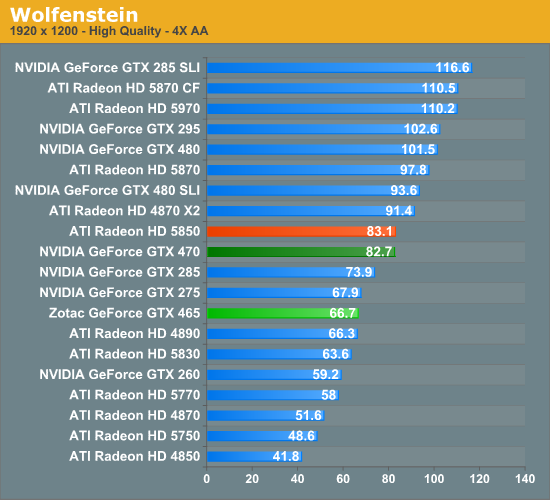
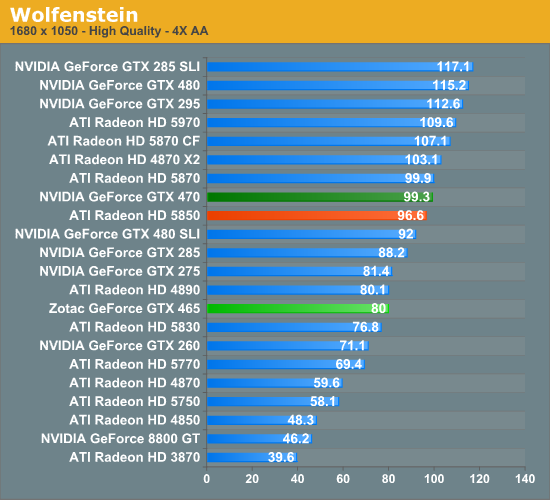
OpenGL was once an NVIDIA stronghold, but when it comes to Wolfenstein those days are gone. The GTX 465 starts behind the 5850 by 18%, and caps that at 25% at 2560. This is also another game where the GTX 465 falls behind the GTX 285, this time by around 10% at all resolutions.
Power, Temperature, & Noise
In our GTX 480 review, we identified both the GTX 480 and GTX 470 as being abnormally hot & loud. Perhaps with the reduction in functional units and a lower memory clock speed NVIDIA will be able to bring this in to check? Let’s find out.
Or not.
Let’s first start with core voltage. For the GTX 400 series NVIDIA does not use a single voltage for each card, instead they assign voltage on a per-chip basis. So while there are trends we can look at, there is no absolute single voltage as we’ve seen on past cards. The following is the load voltage on each of our sample cards.
| GeForce GTX 400 Series Load Voltage | |||
| GTX 480 | GTX 470 | GTX 465 | |
| Load Voltage |
0.959v
|
0.962v | 1.025v |
In terms of core voltage the GTX 465 ends up being a notable outlier. Our GTX 480 and 470 samples have a load core voltage of 0.959v and 0.962v respectively according to GPU-Z, while our GTX 465 from Zotec is a good 0.04v higher at 1.025v. This is only a 4% increase in core voltage overall, but as GF100 has an idle voltage of .875v, this means it takes a 50% greater voltage increase over idle to bring our GTX 465 to load compared to our GTX 470.
NVIDIA is dealing with some very tight thermal and power requirements on the GTX 480 and 470 – getting a 3 billion transistor chip to not run amok drawing power is hard work. From this we can infer that NVIDIA is not only holding back chips with damaged functional units, but also chips that run but just take too much voltage (and ultimately power) to do so. With fewer functional units, the GTX 465 has a greater tolerance for high-voltage chips and it looks like this is where NVIDIA is sending some of them as a result. This is why there’s only a 15W TDP difference between the two cards: NVIDIA “spent” their savings getting lesser GF100 GPUs in to products. So going by voltage alone, it’s clear that we’re not going to see the GTX 465 receive a huge benefit in terms of power, temperature, & noise.
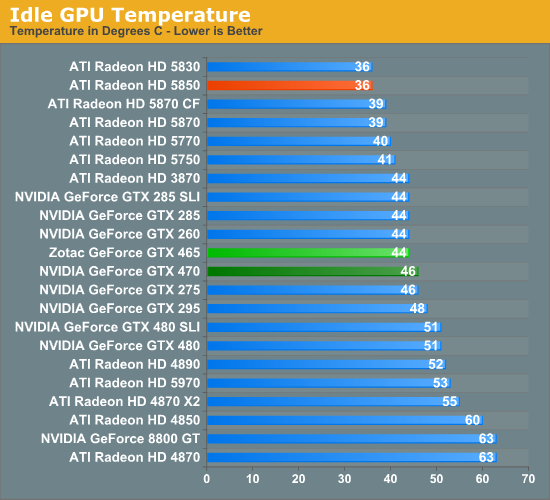
Moving on to our charts, we’ll start with idle temperatures. Even with the same idle voltage and same cooler as the GTX 470, the GTX 465 delivers a slight surprise: it ends up idling at 2C under the GTX 470. This puts it squarely in the same territory as the GTX 200 series.
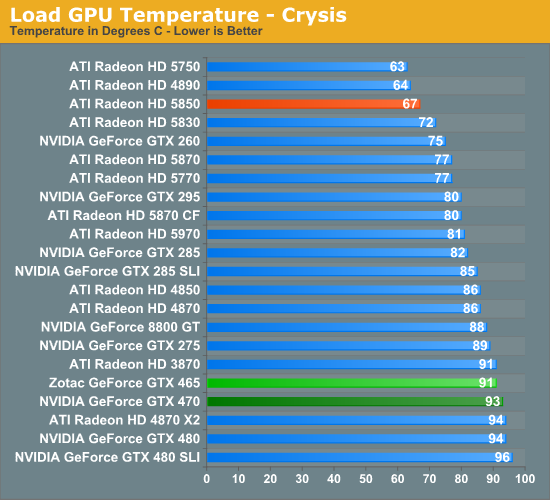
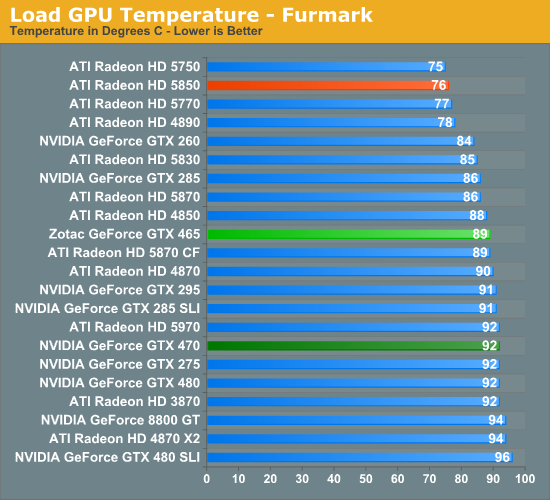
Moving on to load temperatures, we can begin to see the price of using a GPU with a higher core voltage. Under Crysis that 2C advantage over the GTX 470 holds, with temperatures peaking at just 91C. This still makes it the 3rd hottest single-GPU card we have tested, tieing with the Radeon HD 3870 and coming in 24C hotter than the 5850, a card it underperforms in this game.
FurMark has a similar showing, with the GTX 465 coming in 3C cooler than the GTX 470. Overall things are better for the GTX 465 here though, as it’s better than roughly half of our cards here, placing amongst the Radeon HD 4890, 4850, and only a hair above the 5870 and GTX 285. Even the gap between the GTX 465 and 5850 drops quite a bit, with only 13C separating the two.
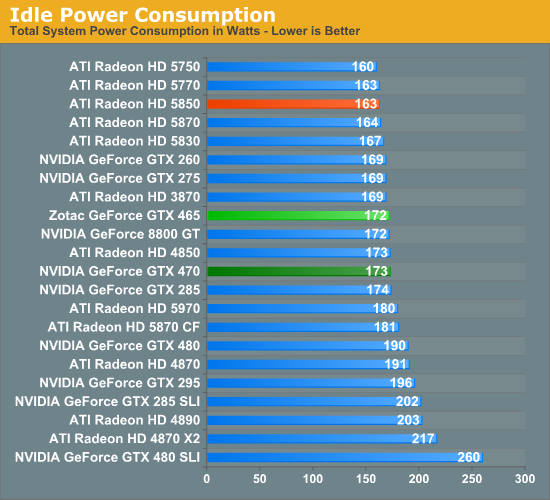
Next we have idle power consumption, measuring the total power consumption of our GPU testbench. While NVIDIA didn’t give the GTX 465 an official idle power draw, we’re measuring it at 1W less than the GTX 470. The GTX 470 was rated for 33W, so it’s safe to say the GTX 465 is close to that. It’s quite likely that the difference comes down to the savings from running 2 fewer GDDR5 RAM chips.
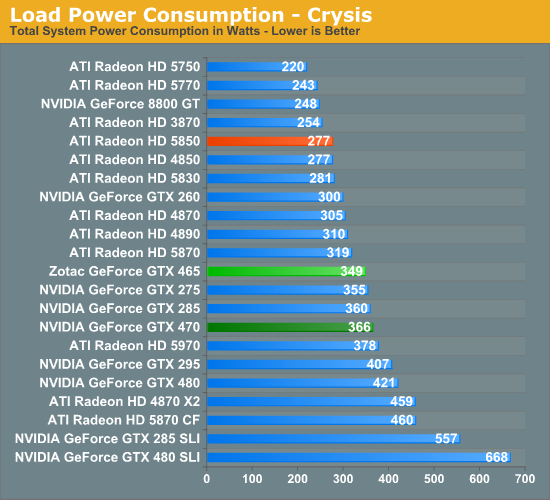
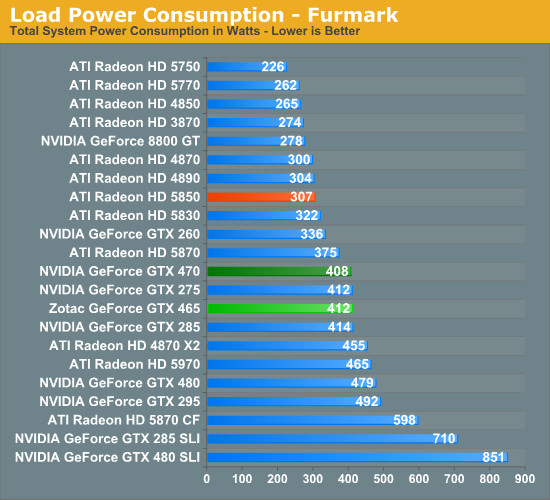
As for load power draw, having seen our temperature results the actual power figures should not be a surprise. Under Crysis the GTX 465 has more in common with the GTX 470 than the power-saving Radeon HD 5000 series, drawing 17W less than the GTX 470 and 72W more than the 5850. Based on our voltage numbers from earlier and this data, it’s clear that NVIDIA had to give up a lot of power savings to make this specific GPU operate.
Meanwhile under FurMark we see those savings evaporate in to nothingness. Here the GTX 465 actually surpasses the GTX 470 by 4W, coming in at 412W versus 408W. At this point it’s drawing as much power as a GTX 275/285, and 105W more than the Radeon 5850. We did not expect the GTX 465 to end up drawing more power than the GTX 470 here, as the 2 fewer RAM chips should have offset the difference. Looking at just the GPU, there’s a good chance the GPU in our GTX 465 card is drawing more power than the GTX 470 under most situations.
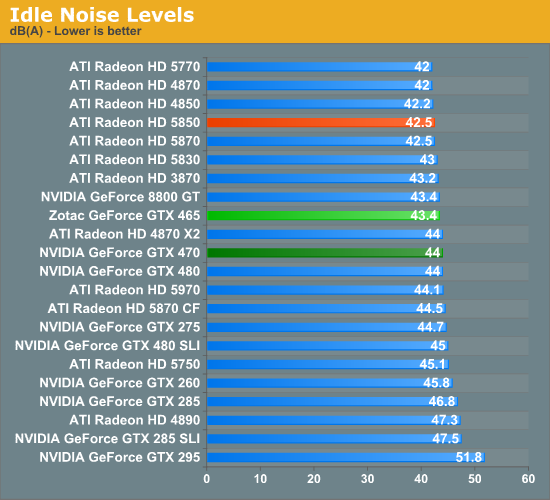
Last but not least we have our noise testing. As the GTX 465 uses the same cooler as the GTX 470, the results should be very close and our idle noise measurements deliver on that. Our GTX 465 idles at 43.4db(A), effectively tied with the GTX 470 and only marginally different than most of the rest of our cards.
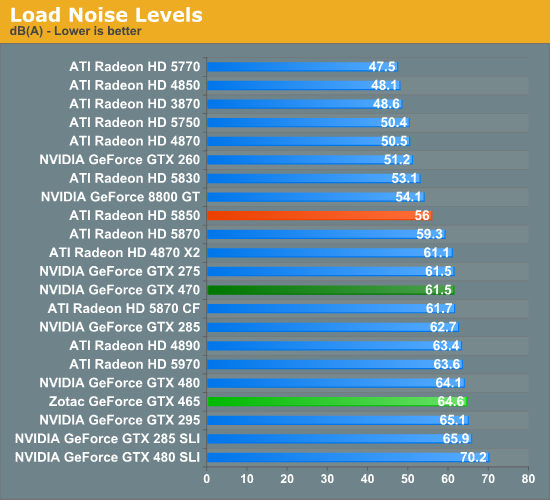
When we first did our load noise testing on our GTX 465, we thought something was wrong. It sounded louder than the GTX 480 or GTX 470, and when we put a sound meter to it the results reflected that. But after triple-checking our results there’s nothing wrong with our data – the GTX 465 really is louder than the GTX 470 and the GTX 480. As fan speeds are tied to the GPU temperature we’re looking at the culprit being the fan profile used for the GTX 465, as the hardware is identical to the GTX 470. It looks like NVIDIA tweaked the GTX 465 to be a bit more aggressive than the GTX 470, which in turn makes this the likely reason why we’ve measured the GTX 465 as being cooler than the GTX 470 in spite of their similar power draw.
Our best guess here is that with the GTX 465’s higher operating voltage, NVIDIA wanted a slightly lower operating temperature to compensate. As with any other case where we’ve only measured a single card there’s the possibility of a great deal of variation, but what we’ve seen makes sense. Across the entire spectrum of GTX 465 and GTX 470 cards it’s reasonable to assume this data is correct and that the GTX 465 is on average a couple of db(A) louder than the GTX 470.
It goes without saying that this isn’t a reasonable amount of noise for the performance the card delivers. The Radeon HD 5870 is 5dB(A) quieter, and the 5850 extends than to 8dB(A) quieter. At these noise levels 8dB(A) is a very noticeable difference.
Conclusion
We opened this article stating that the “sweet spot” for NVIDIA was 93%. The GeForce GTX 465 is 93% of the price of the average Radeon HD 5850, so NVIDIA would want to deliver at least 93% of the performance. All told they come very close to this at 1920 and 1680, coming within 89% and 93% of a Radeon HD 5850 respectively, showcasing just how good of a job NVIDIA is doing positioning their cards as of late.
Unless you’re going to be gaming with a 30” LCD, NVIDIA has done an appropriate job of pricing the GTX 465 on a pure performance basis. For $280 you can have a GTX 465, or for 8% more you can have a card that performs 8% faster (the 5850). If that’s all you care about, stop here and figure out how much you wish to spend and you’ll be able to figure out which card you want.
However if we continue on, there’s an ugly truth to face: the GTX 465 delivers the GTX 470’s power and noise characteristics, but not the GTX 470’s performance. This is a critical difference because while we could make a case for the GTX 470 versus the 5850 based on the former’s superior performance, now we’re looking at a card that is slower than a 5850 but worse in every basic metric except price. The GTX 465 is much louder and much more power hungry than the Radeon 5850 all while being slower – and all you save is $20.
At this point it’s impossible to recommend the GeForce GTX 465 for the average buyer. The extra $20 for a Radeon HD 5850 will buy a card that is cooler, quieter, and appropriately faster. Unless you’re on an edge case and need to be in the NVIDIA ecosystem for a specific reason such as CUDA, 3D Vision, or DX10/11 transparency anti-aliasing (more on this later this week), a 5850 is going to be the better card. NVIDIA is going to have to drive the feature differences between the GeForce GTX 400 series and the Radeon HD 5000 series to sell the GTX 465, as performance won’t do it.
Meanwhile on a broader horizon, we noticed something interesting about the GTX 465: it’s really, really close to the GTX 285. In terms of gaming performance the difference is under 4%, while temperatures, power consumption, and even noise were all very close to NVIDIA’s last-generation king. Whether it was intentional or not, the GTX 465 feels like a GTX 285 with DirectX 11. At nearly 2 years old the GTX 285’s place in the world has been well established in most enthusiasts’ minds and the GTX 465 actually fits this mold nicely. This isn’t necessarily a good thing since we’ve moved on to 40nm and the Radeon HD 5000 series, but if you’ve ever wanted to know what a GTX 285 with DirectX 11 would be like, we would imagine it would be a lot like the GTX 465.
We'd like to once again thank Zotac for providing their GeForce GTX 465 for today's review

